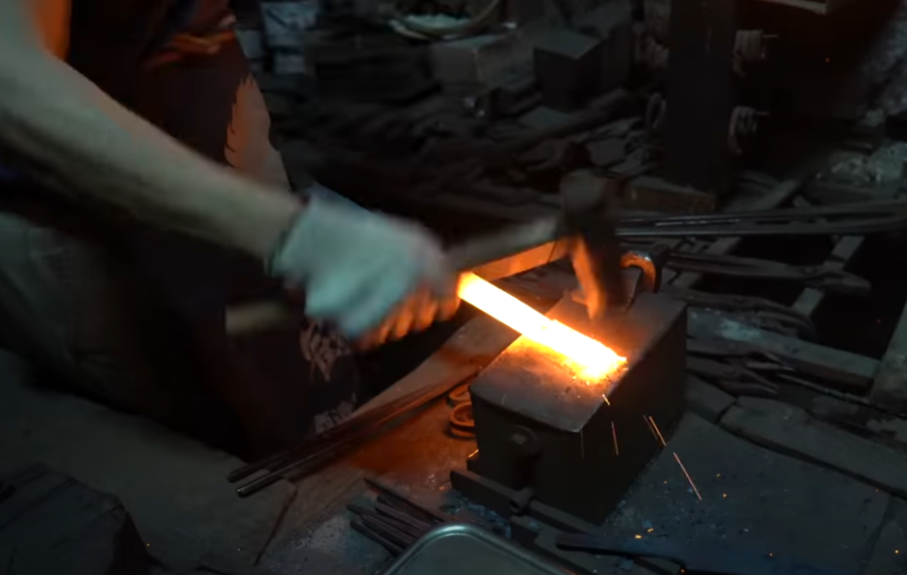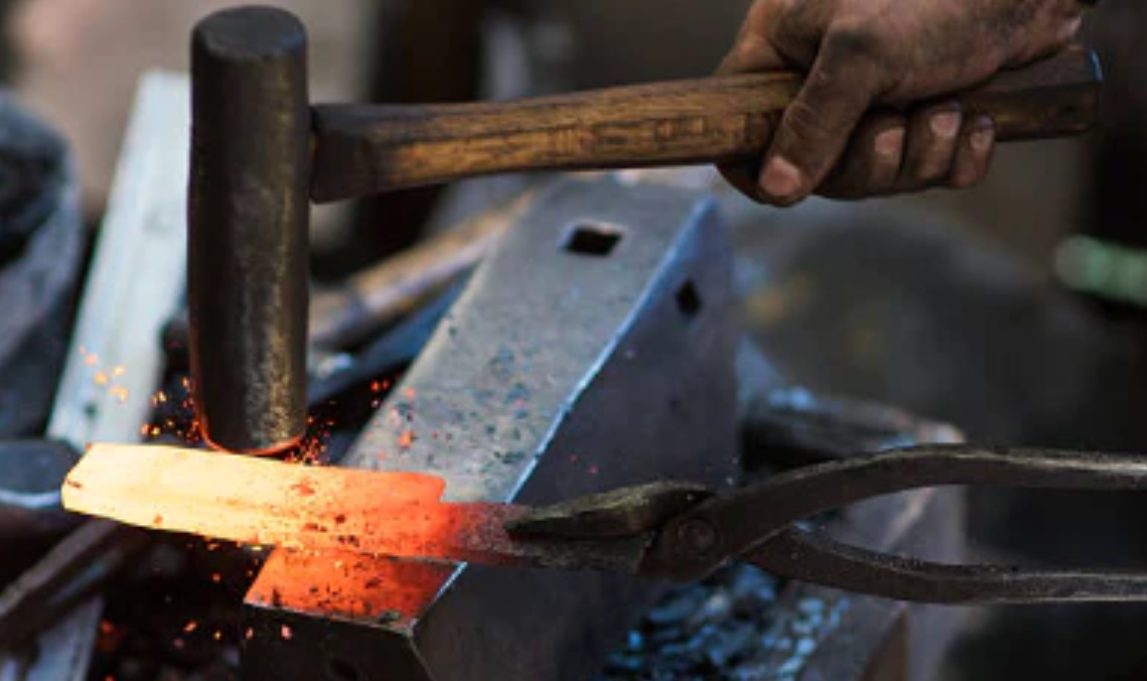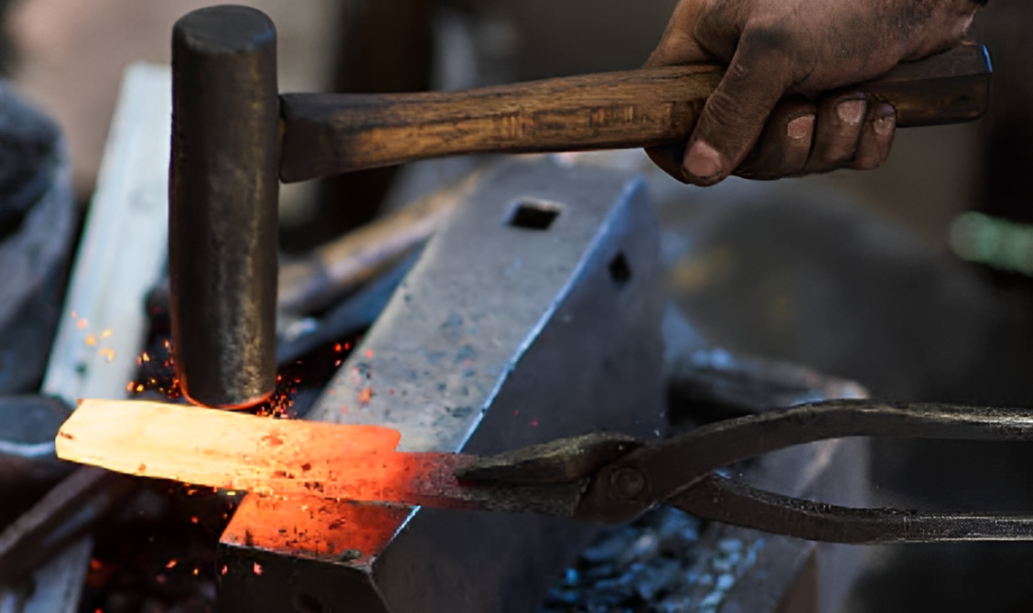
Preventing Rust in Japanese Knives
-
Japanese knives are renowned for their sharpness and beauty, but without proper care, they can easily rust. This page details the causes of rust, differences between easily rusting and rust-resistant steels, daily maintenance methods, storage methods, and rust removal techniques for Japanese knives.
-
1. What is Rust? The Mechanism and Causes of Rust
-
Let’s start with the basics. Rust is formed when iron reacts with oxygen in the presence of moisture. The iron contained in metal interacts with the oxygen in air or water, forming iron oxide, or rust.
-

-
Iron is prone to rusting because its raw material, iron ore, is already in an oxidized state—its natural form is rusted. In fact, the rusted state is iron’s most stable form. This means that when you remove rust from the surface of iron, it immediately begins to rust again. This is the inherent nature of iron.
-
To prevent rust, it’s important to block out oxygen and moisture. When these two elements are present, iron oxidizes, and rust begins to form. By coating the surface of iron to shield it from oxygen and moisture, you can prevent rust from progressing.
-
Interestingly, rust does not form in space. This is because there’s no oxygen or moisture in space. However, on Earth, where oxygen and moisture are always present, the progression of rust is unavoidable.
-
The Cause of Rust in Japanese Knives
The cause of rust in Japanese knives is the same. The iron content in the steel of Japanese knives reacts with oxygen and moisture in the air, causing rust to form. This process is especially accelerated in high-humidity environments.
-
By understanding how rust forms, we can better grasp why iron and knives are prone to rusting and how we can take steps to prevent it.
-
2. Differences Between Carbon Steel and Stainless Steel: Rust Susceptibility
-
Carbon steel is prone to rust, while stainless steel is more resistant to it. However, even knives made of stainless steel can develop red rust if not properly maintained. In particular, Japanese knives made of carbon steel require appropriate care, such as wiping off moisture immediately after use, to prevent rust from forming.
-
Stainless Steel and Rust Resistance
Now, let’s discuss stainless steel. Stainless steel is an alloy made by adding at least 10.5% chromium to iron. Chromium plays a crucial role in preventing rust by forming a thin protective layer on the surface of the metal, called an oxide film. This layer, also known as the passivation film, is so thin that it’s invisible, but it effectively blocks the progression of rust.
-
Chromium reacts with oxygen more readily than iron, forming the oxide film before iron starts to rust. This thin layer of rust makes the metal "believe" it has already rusted, thus preventing further corrosion. This explains why stainless steel is highly rust-resistant, though not entirely rust-proof. It possesses significant resistance to rust under normal conditions.
-
Understanding the Differences in Rust Between Carbon Steel and Stainless Steel
By understanding how iron rusts and why stainless steel is more resistant to rust, it becomes clear why carbon steel is particularly vulnerable to rust, while stainless steel is far more durable in this regard.

Material of Knife
The knives we carry at KIREAJI are made of various materials. The harder the material, the longer the sharpness lasts, but it tends to be harder to sharpen.
-
3. Essential Knife Maintenance: How to Prevent Rust and Prolong Durability
-
Regular knife maintenance is crucial for preventing rust. By following these three fundamental steps, you can ensure that both stainless steel and carbon steel knives remain resistant to rust.
-
(1) Thoroughly Clean Residue:
After use, make sure to wash off any food particles, oils, or residues from the knife. Neglecting this step can leave behind components that lead to rust.
-
(2) Proper Drying:
After washing, thoroughly dry the knife to remove all moisture. Carbon steel knives, in particular, are sensitive to humidity, and even a small amount of water left on the blade can quickly lead to rust.
-
(3) Store in a Well-Ventilated Area:
Store the knife in a dry, well-ventilated place where it is protected from water splashes. High humidity environments increase the risk of rust, so keep your knife in a dry location. -
By adhering to these three steps, you can maintain rust resistance across all knife materials. Even with frequent use, this method will help extend the lifespan of your knife.
-

-
4. Maintenance Tips for Long-Term Knife Storage
-
If you do not use your knife for an extended period, improper maintenance can lead to severe rust, causing irreversible damage. To protect your valuable knife, follow these essential steps.
-
(1) Thorough Cleaning and Drying
First, make sure to wash off any dirt, food residue, or oils completely. After washing, thoroughly dry the knife to remove all moisture. Even a small amount of water left on the blade can cause rust to develop over time. -
(2)Apply a Thin Layer of Blade Oil
While storing the knife as-is may be fine in some cases, applying oil to the entire blade provides an extra layer of rust protection. We strongly recommend wiping the blade with blade oil before storage.
-
Rust forms when iron comes into contact with oxygen and moisture. However, coating the blade with oil creates a protective film, preventing oxygen from reaching the metal surface.
-
One of the best choices for this is camellia oil, a non-drying oil that remains effective for long-term storage.
-
Avoid Using Cooking Oils Like Vegetable Oil
Many people ask, "Can I use vegetable oil instead of blade oil?" The answer is no.
-
Most vegetable oils are drying or semi-drying oils, meaning they tend to dry out over time and become sticky. Additionally, cooking oils can oxidize and go rancid, making them unsuitable for long-term storage.
-
(3)Wrap in Newspaper Before Storing
After applying oil, do not store the knife directly in a knife block or drawer—wrap it in newspaper instead.
-
Kitchens tend to have high humidity, which increases the risk of rust. Newspaper helps absorb excess moisture while also preserving the oil coating on the blade.
-
By following these steps, you can protect your knife from rust and ensure its longevity. Keep your knife in optimal condition so that it’s always ready for use when you need it.
-
5. Rust Removal Methods
-
(1) Mild Rust
Gently polish with a detergent containing abrasives. If rust is difficult to remove, use rust remover or rust eraser. You can also use tricks like polishing with a wine cork or a piece of radish with cleanser.
-
(2) Severe Rust
Carefully polish with sandpaper or steel wool. After polishing, wash with neutral detergent and thoroughly dry. Finally, apply cooking oil to protect. For rust on the blade edge, it is recommended to sharpen the knife. Soak the whetstone in water, and while removing rust from the blade edge, carefully sharpen the knife to restore its sharpness.
FAQ About Preventing Rust in Japanese Knives

01. Does rust affect the sharpness of a knife?
Absolutely. Rust buildup dulls the blade and compromises cutting performance. Regular maintenance is essential to preserve both sharpness and longevity.
02. How can I reduce the risk of rust?
Carbon steel knives are highly sensitive to moisture and can develop rust in as little as five minutes if left wet. To prevent this:
・Wash the knife immediately after use
・Pour hot water over the blade to promote quick drying
・Wipe thoroughly with a clean, dry cloth
・Apply a thin layer of oil for added protection
Stainless steel knives offer better rust resistance and require less maintenance, making them ideal for those concerned about rust.
03. What should I do if I notice black rust?
If black rust appears near the cutting edge, simply sharpen the knife with a whetstone to remove it.
If it's elsewhere on the blade:
・Gently rub the area with a wine cork, a mild cleanser, or a dedicated rust remover
・Note that black rust does not compromise knife performance or safety
In fact, some believe that naturally formed black rust provides a protective "patina" and prefer to leave it untouched, especially if developed over years of use.
04. My steel knife has discolored. Is that a problem?
Slight discoloration can occur from contact with fats, fish, or vegetable residue.
・This does not affect functionality or safety, provided the knife is cleaned properly
・However, discoloration may appear unhygienic and can sometimes hide early signs of red rust
To remove discoloration:
・Rub the affected area with a wine cork or the base of a vegetable (e.g., potato) using a mild cleanser or polish
・After polishing, lightly sharpen the knife to restore its edge if needed
05. What should I do if I see red rust?
Red rust requires immediate attention, as it can spread and cause deep corrosion.
To remove red rust:
・Use a wine cork or vegetable base with cleanser to rub it off
・For deeper rust, use a whetstone to sharpen the affected area
・Where sharpening isn’t possible, use waterproof sandpaper to clean the surface
Why Are Japanese Stainless Steel Knives So Rust-Resistant?

The Origin of Craftsmanship
-
Rust Is Not the Enemy — It’s a Mark of Time Well Spent
The Hidden Beauty of Rust
Rust often gets a bad reputation. To many, it’s a sign of neglect or decay.
But what if we saw it differently?When it comes to Japanese knives, rust isn’t just deterioration — it’s proof that the knife has lived, been used, and stood by your side in countless meals.
Like the lines on a seasoned craftsman’s hands, rust tells a quiet story of time, effort, and care.
-
Rather than seeing rust solely as deterioration, consider it as a testament to how the knife has been used and the time it has endured.Surface Rust vs. Deep Rust — And How to Handle Both
Not all rust is equal.
- Surface rust is usually harmless and can be gently polished away.
- Deeper rust, however, can begin to eat into the blade, leaving pitting or cavities — much like a cavity in a tooth.
But don’t worry: even then, with careful polishing and sharpening, many knives can be brought back to life. You’re not just restoring steel — you’re continuing the journey of a trusted tool. With this perspective, you'll discover a deeper value in its story.
-
Don’t Fear the Rust — Welcome the Ritual
The tools don’t matter as much as the heart you bring to the task.
Whether you're using a rust eraser, cork, or even a daikon radish with a bit of cleanser — what counts is the mindset: “I care for this knife because it matters.”That small ritual of polishing, of watching your blade regain its sheen, is more than maintenance —
it’s an act of respect. A connection between you and your knife. -
A Knife That Ages Gracefully, Like Its Owner
A Japanese knife is not meant to stay pristine. It’s meant to grow with you.
It reflects your habits, your rhythm, your seasons of cooking.Each stain, scratch, or patch of rust is part of your story together.
So the next time you see rust forming, don’t rush to judge it.
Instead, pause. Clean it gently. And thank your knife for what it’s helped you create.

Would you like to experience the sharpness of handcrafted knives from Sakai City, used by 98% of Japanese chefs?
Through our exclusive partnership with Shiroyama Knife Workshop, we bring you top-quality knives. In addition, we offer free Honbazuke sharpening, a protective Saya, and paid after-sales services to ensure long-term confidence.
KIREAJI's Three Promises to You
-

1. Exceptional Japanese Knives
Our knives, crafted by Sakai City's master artisans, combine traditional techniques with carefully selected materials, delivering unrivaled sharpness and durability.
-

2. For a Lifetime of Use
At KIREAJI, we see knives as lifelong companions. Each knife comes with a free saya, and we offer Honbazuke hand-sharpening by Shiroyama Knife Workshop in Sakai City.
-

3. Supporting the Joy of Continued Use
KIREAJI knives are made to grow with you. That’s why we provide trusted after-sales care (fee-based) .





